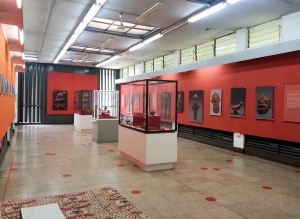It is a couple of months since the Koma figurines exhibition Fragmentary Ancestors came to an end at Manchester Museum. That was not the end of the story, however, because after the end of the exhibition in Manchester the figurines were shipped back to Ghana and the exhibition was recreated in the museum in Accra. From there the figurines will travel back to Yikpabongo in Koma Land where they will be displayed for the enjoyment of local people and to stimulate tourism.
You can read a review of the exhibition in the Journal of Museum Ethnography:-
Pole, L. (2014). Fragmentary Ancestors: Figurines from Koma Land, Ghana (Manchester Museum, University of Manchester). Journal of Museum Ethnography 27, 168-174.
Despite the fact that high temperatures typically accelerate DNA damage, and consequently there are only a few previous reports of the recovery of ancient DNA from exposed sites in Sub-Saharan Africa, Professor Terry Brown and PhD student Heather Robinson managed to recover ancient DNA from inside three of the figurines using forensic-style swabs and a magnetic extraction method.
A member of Manchester Museum’s conservation team, Irit Narkiss, accompanied the figurines with a Ghanaian courier and helped re-install the displays. Thanks to the sterling work of Peter Farmer of FDA Design, the graphics were made in such a way that they could be dismantled and travel to the new venue.
Here you can see the dedicated team at Accra Museum installing the figurines in the new displays. Francis, the Ghanaian courrier, tells me that exhibition from June to July 2014 attracted 1,134 and 1,945 visitors respectively. We wish the Ghanaian Museums and Monuments Board every success and we thank them for kindly entrusting the figurines to us for the temporary exhibition at Manchester Museum.
Attentive Ancient Worlds blog readers will no doubt recall that the figurines were made by a previously little-understood people in Koma Land in Ghana in West Africa between approximately 500 and 1300 AD. This corresponds broadly-speaking to the early to mid Medieval Period in Britain.
We don’t know a great deal about how the figurines were used but it would appear that they were used in special ceremonies and rituals in which the spirits of the ancestors were invoked. In the course of these ceremonies the figurines were deliberately broken. The fragments are often found in mounds, possibly because they were felt to have residual power and had to be disposed of carefully.
When they are discovered in the ground the figurines are often fragmentary but depict stylised two-headed creatures, bird figures, and animals. It is thought that they represent the ancestors. It is possible that cavities and channels in the figurines had liquid offerings or libations poured into them, and that some might have been linked with healing and medicine.
Whilst the figurines were in Manchester detailed scanning was carried out to study these channels in detail and to try and identify any substances that might survive in them. Once the presence of substances was confirmed by the scans swabs were taken by researchers at University of Manchester in order to analyse the DNA and identify the nature of the material. This work is at an early stage though I gather the preliminary indications look promising. I hope to report about this in a future blog post.
The figurines were discovered during archaeological fieldwork directed by Professor Ben Kankpeyeng (University of Ghana) working with Professor Tim Insoll (University of Manchester) and the Ghana Museums and Monuments Board. The Fragmentary Ancestors exhibition was made possible thanks to generous grants from the Wellcome Trust, the Zochonis Trust and the Morel Charitable Trust, to all of whom the Museum is very grateful.



Pingback: Fragmentary Ancestors Figurines from Koma Land Exhibition | Ancient Worlds
Pingback: Koma Figurines Interview with Mr Saibu at Manchester Museum | Ancient Worlds